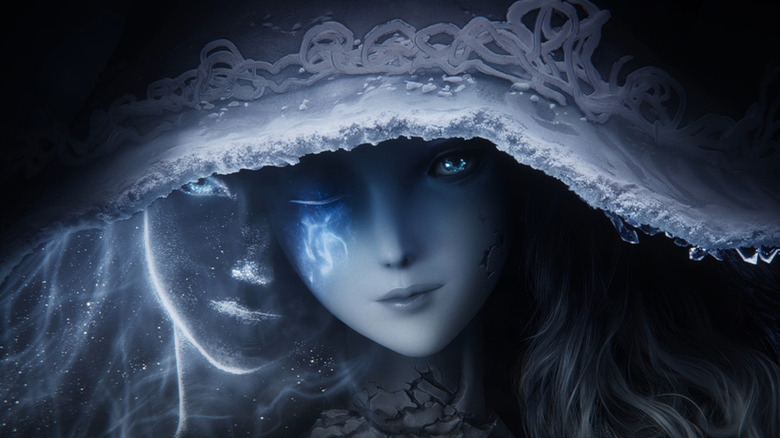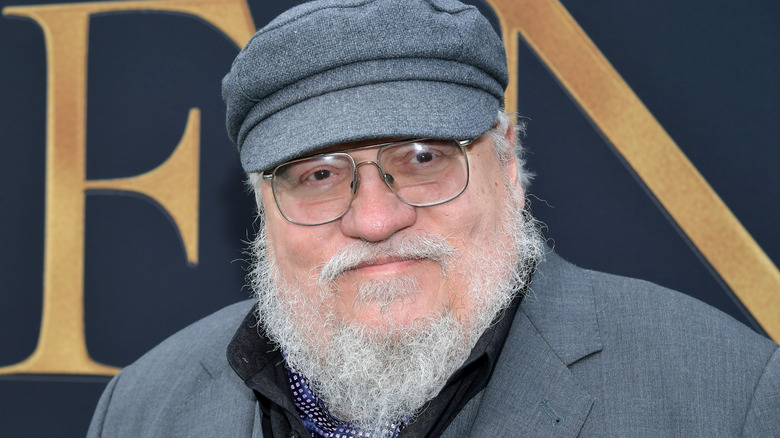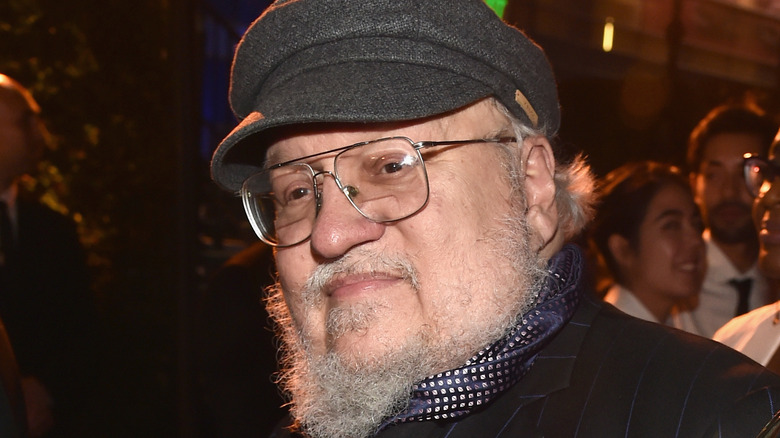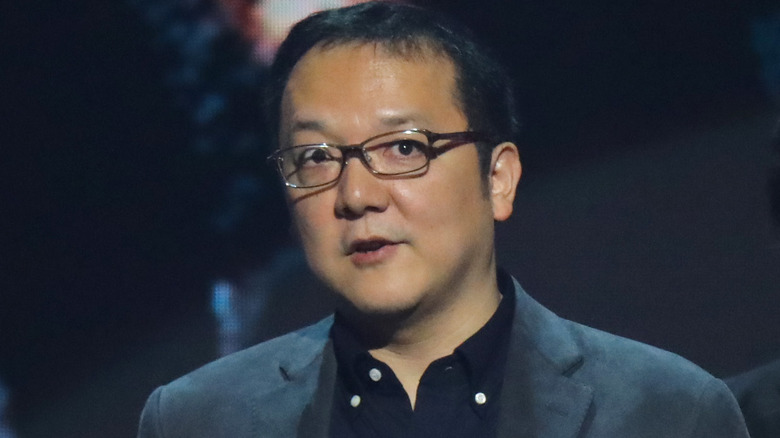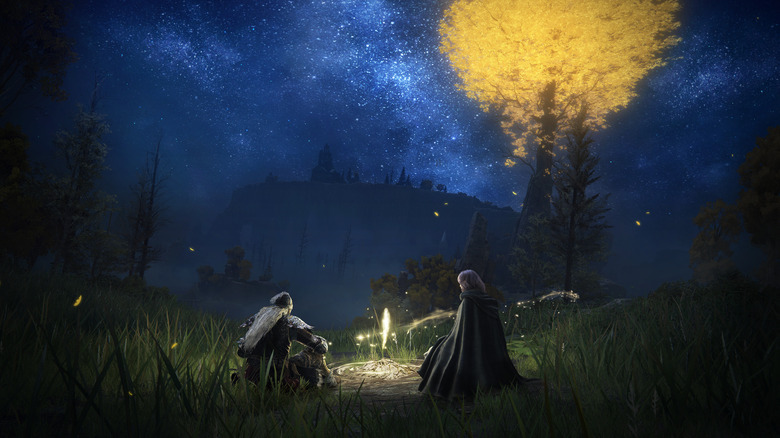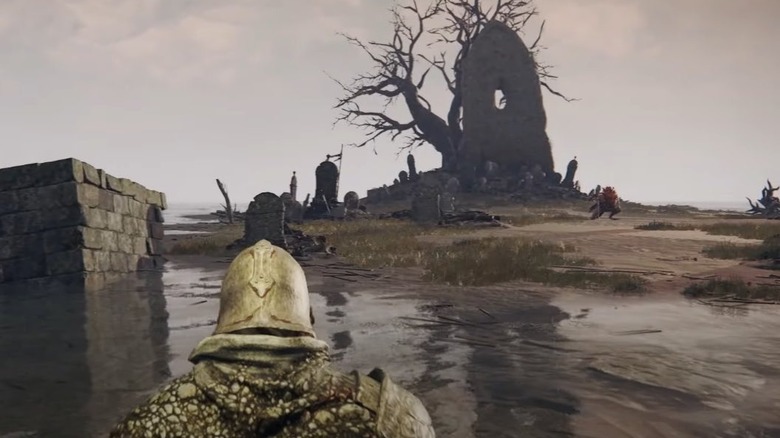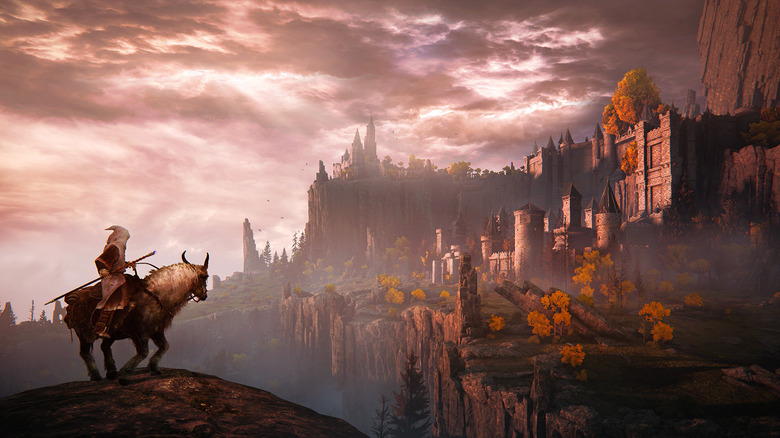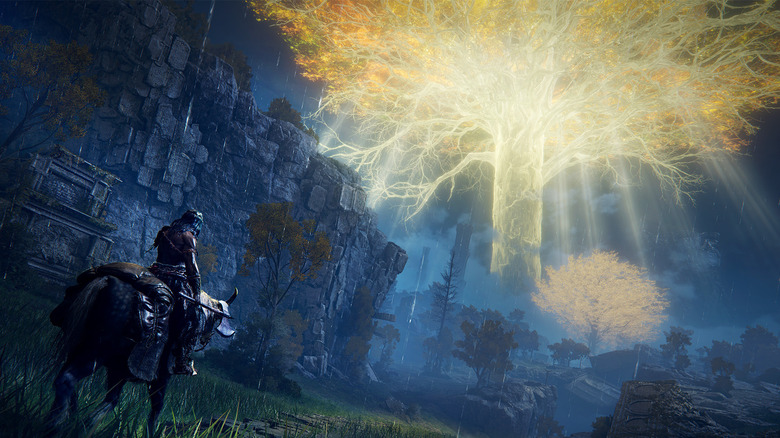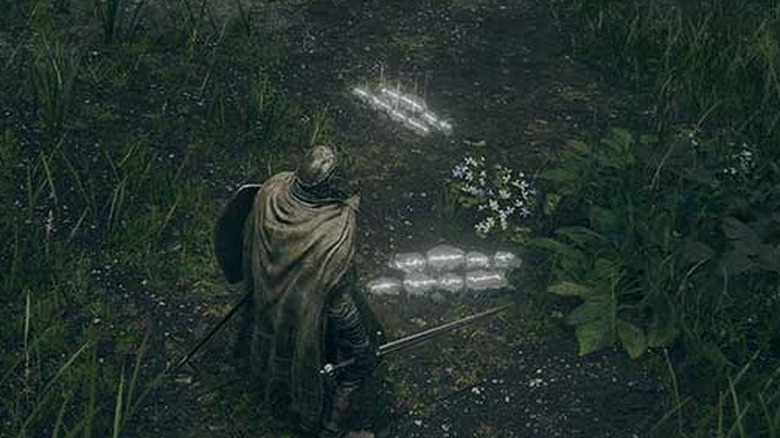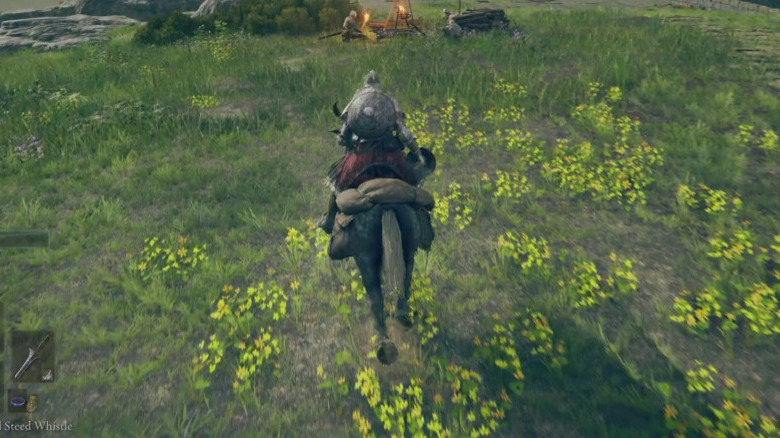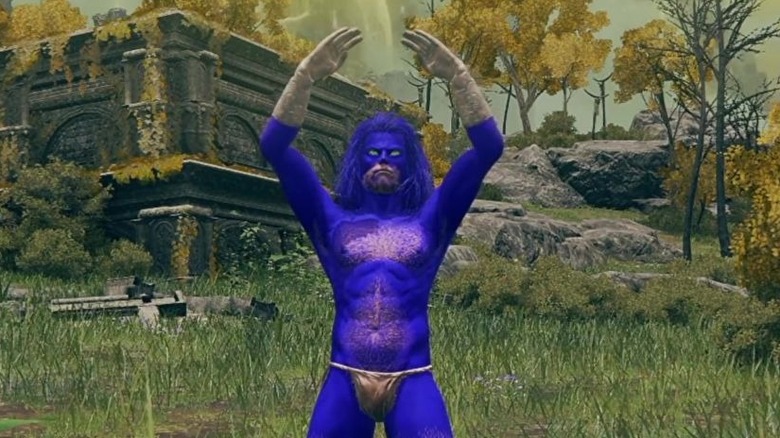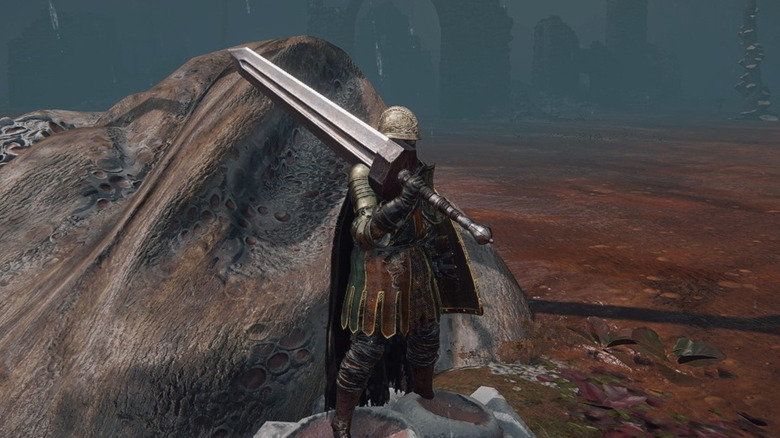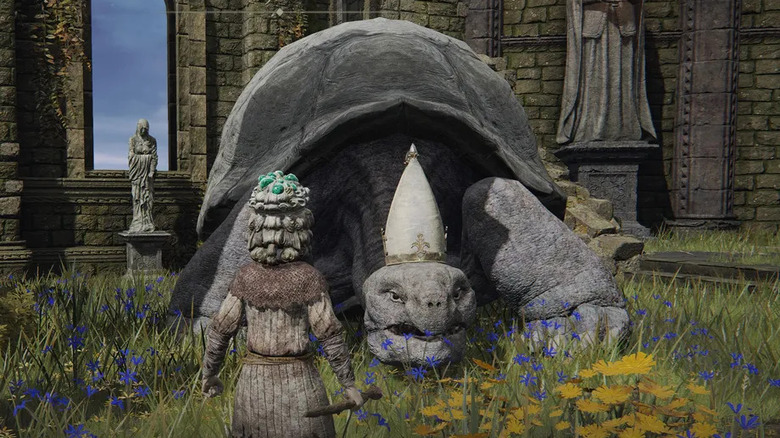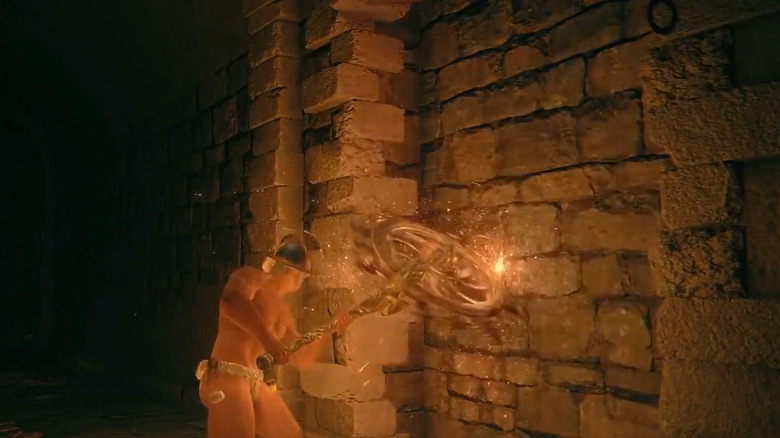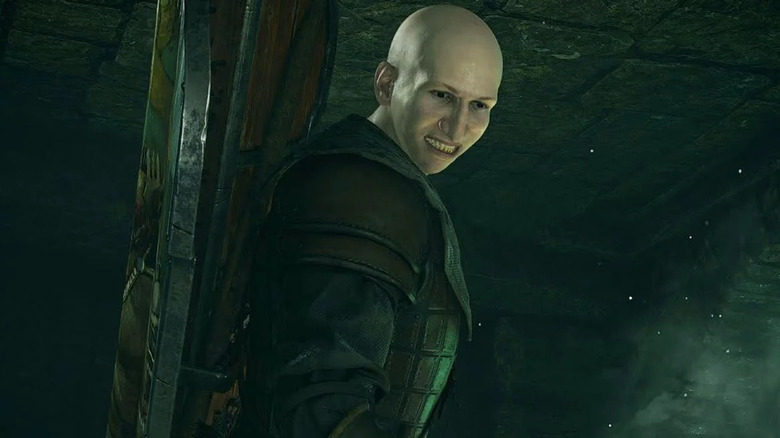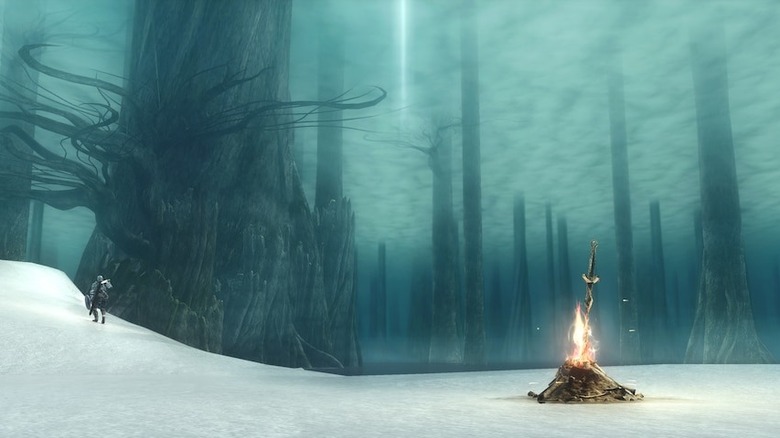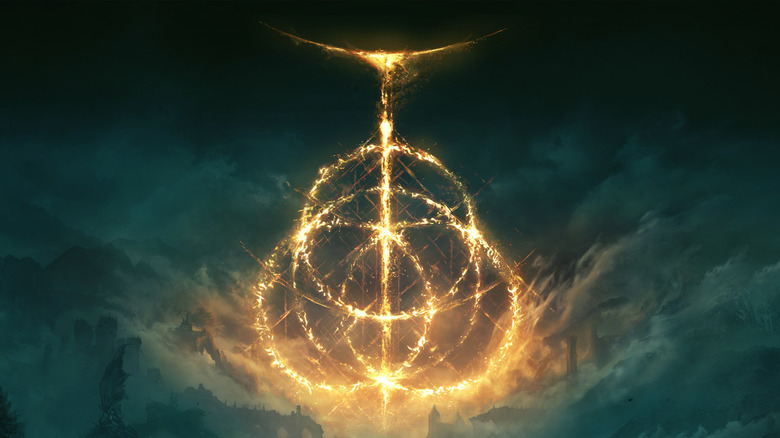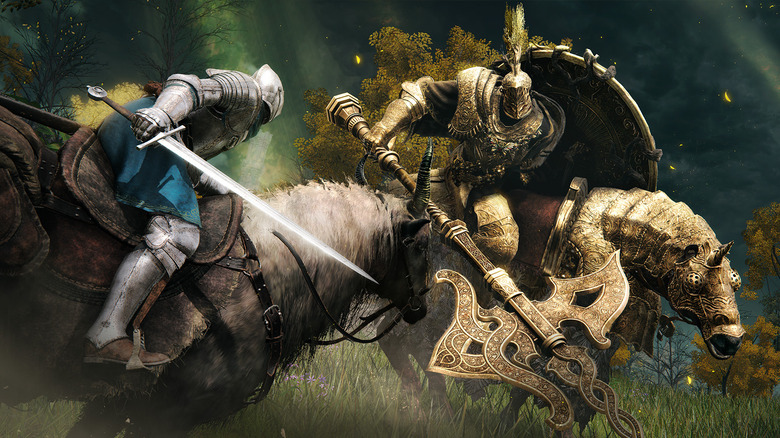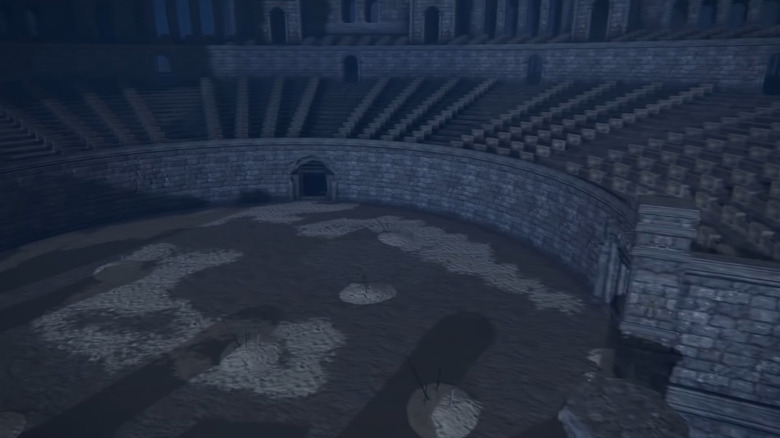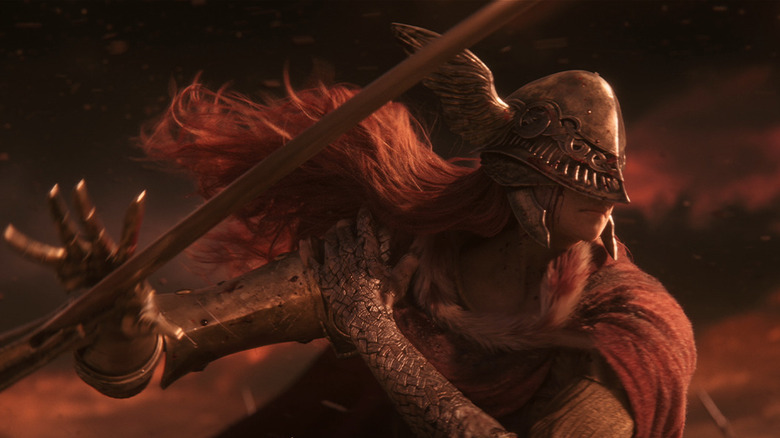The Untold Truth Of Elden Ring
Announced to a wave of excitement at E3 2019, "Elden Ring" has been on everyone's radar for a long time. And now that it has hit stores and players have had some time to dive into its wondrous depths, fans are left with a formidable impression. Players and critics have largely called "Elden Ring" one of the best games in recent times.
"Elden Ring" is great for many of the same reasons that "Dark Souls" captured players' imaginations. It's a grueling challenge that takes true, methodical effort to overcome. "Elden Ring," like other FromSoftware titles, follows the same uber-difficult formula that has made the loosely-connected series into a sub-genre all its own.
But great games don't just appear out of nowhere. They normally come from a long period of refinement. The crucible of development doesn't often spit out near-perfect final products like "Elden Ring," so fans may wonder about the development and history of this masterful tour de force in gaming.
It's time to take a look at the inspirations behind "Elden Ring" and where it stands in FromSoftware's greater "Soulsborne" universe, all while answering questions players didn't even know they had!
How involved was George R.R. Martin?
The marketing for "Elden Ring," ever since its announcement in 2019, touted itself as a FromSoftware collaboration with George R.R. Martin. The author of the wildly popular "A Song of Ice and Fire" book series (which led to HBO's "Game of Thrones"), Martin brought with his name great esteem and interest from fans.
The finer details of Martin's impact on the production of "Elden Ring" is somewhat murky. However, an interview conducted by IGN with FromSoftware CEO Hidetaka Miyazaki clarified some of Martin's contributions. Digging deep into unanswered questions about the setting's lore, Miyazaki constantly referred back to Martin in complementary terms, describing the process as "a really great collaboration."
According to Miyazaki, Martin composed an overarching world mythos for "Elden Ring," which was intended as a jumping-off point. In contrast, FromSoftware typically develops its game mechanics first, then gets into world-building. But Martin's ideas were too good to pass up, so "Elden Ring" instead started with Martin's writings, which focused on, "The flow of history and the figures who appear throughout it." (per GamesRadar).
Martin's specific contributions included the name for The Lands Between, the concept of tainted demigods, and the theme of people reclaiming their lost grace. Miyazaki told IGN, "We had this initial impetus from George R.R. Martin's mythos and we used that to paint the foundation and the initial layers of the game."
While Martin downplays his involvement on his personal blog, the respect and credit shown from Miyazaki suggests that the legendary fantasy author played a sizable role in the game's success.
Did George R.R. Martin sneak his initials into the lore?
Even if someone didn't know much about "Elden Ring," they might have easily gathered that the author of "Game of Thrones" was involved. His name was inserted into every article, review, and blog post for "Elden Ring's" popular release.
Some internet sleuths discovered that the author's initials seemed to be littered throughout the game's lore (via Input Mag). The fun theory points out that several character names with one of the author's initials: For G, there is Godrick the Grafted and his ancestor, Godfrey. For R, there is Rennala, Radagon, Radahn, Rykard, and Ranni. And for M, there is Queen Marika, as well as her children Malenia and Miquella, not to mention Melina. Each of these are main characters within the "Elden Ring" mythos, so it couldn't just be a coincidence that all their names start with either G, R, or M, right?
Well, according to George R.R. Martin, it is all a coincidence. To set the record straight in one of his personal blog posts, Martin concluded, "I have been writing and publishing stories since 1971, and I suspect that I have been giving characters names beginning with R and G and M since the start. Along with the other twenty-three letters of the alphabet as well." Perhaps amused at this theory, Martin further asked, "why would I have to hide my name inside the game? My name is right there ON the game, as one of the creators."
How Hidetaka Miyazaki views Elden Ring's difficulty
"Elden Ring" is an intentionally unforgiving game. Every battle is an intricate dance with death. The game demands the grace of ballerina and the player begins as a stumbling, flat-footed noob. Dying a lot is the intended outcome. Otherwise, how will the player learn?
But where does this unique style of progression-through-failure come from? In an interview with the New Yorker, Hidetaka Miyazaki shared stories from his life that may point to an origin for "Souls"-like difficulty.
He grew up 100 miles southwest of Tokyo, unable to afford the science fiction and fantasy books that he enjoyed at the local library. When he graduated from college, he took a job he didn't enjoy to support his family. On a leap of faith in his late 20s, Miyazaki took a coding role at FromSoftware on the "Demon's Souls" team. He whipped that game into a playable RPG with the dark fairytale furnishings that players have come to expect. Although "Demon's Souls" wasn't a massive success at the time, Miyazaki went on to become the company's CEO and product visionary. And from there, the rest is history.
The New Yorker interview posits that players of "Elden Ring" experience a similar trajectory to Miyazaki, in that they start with nothing and earn mastery through failure and not giving up. Miyazaki denies such simple analogous thinking, saying, "I just want as many players as possible to experience the joy that comes from overcoming hardship." For Miyazaki, the best video games are those that present new challenges around every corner.
How long was Elden Ring in production?
The move from linear corridors to open-world design in "Elden Ring" presented unique challenges for FromSoftware. The game's world is massive and the possibilities of how to traverse it are endless. So how did FromSoftware create a novel experience with this open-world, keeping every area fresh and bug-free? Well, over five years were spent building the game.
In 2019 interview with Xbox Wire, Miyazaki confirmed that production on "Elden Ring" began after the last DLC for "Dark Souls 3," "The Ringed City," was released. That would put FromSoftware working on Elden Ring all the way back around 2017. In the meantime, FromSoftware also stay busy by producing "Sekiro: Shadows Die Twice." Miyazaki told Xbox Wire that the development process for both games were similar. However, he noted, "Unlike 'Sekiro', which has a heavy focus on action, 'Elden Ring' puts more focus on RPG elements."
While "Sekiro: Shadows Die Twice" released on schedule in 2019, "Elden Ring" had its release date pushed back multiple times — much to the displeasure of the FromSoftware community. But that extra time in the oven ultimately resulted in the polished open world seen in "Elden Ring."
This would seem to prove the immortal line that legendary Nintendo developer Shigeru Miyamoto once quipped to The Guardian: "A delayed game is eventually good, a rushed game is forever bad."
Remnants from other FromSoftware games
"Elden Ring," much like fellow FromSoftware titles "Bloodborne" and "Sekiro," invented a new world for FromSoftware to re-flavor its patented combat. The golden-eyed Tarnished in search of lost grace in a world teeming with the spawn of corrupted, mutant demigods? Surely, "Elden Ring" is a breath of fresh air for "Soulsborne" fans. However, the differences between the settings of these games might be less divergent than they first appear.
"Elden Ring" makes plenty of references to other FromSoftware games and wider pop culture. But beyond vague allusions, "Elden Ring" also seems to contain exact models left over from other games. FromSoftware titles have extremely dedicated fans who are well-conditioned to piecing together parts of a puzzle as they figure out the lore of their favorite games. Some of the more well-versed "Souls" historians have spotted remnants of other FromSoftware games popping up in "Elden Ring."
One Twitter poster found the God Grave, an unused asset from "Dark Souls 3: The Ringed City," while playing "Elden Ring." Others have found knights cut from the release of "Bloodborne" hanging out in the Lands Between. Beyond just copy-pasting some fan favorite enemies, weapons, and characters from older games, "Elden Ring" successfully recycles previously cut content from older games and puts them to good use. Because of this, some players have jokingly referred to "Elden Ring" as exemplifying "FromSoftware's Greatest Hits."
Why is the story so obtuse?
Many first-timers to FromSoftware titles have been shocked by the harsh, figure-it-out-yourself style of narrative exposition that "Elden Ring" employs. "Soulsborne" games are famous for their epistolary frameworks. Players only get bits and pieces of disconnected information through letters, found objects, and questionable character testimony. Making concrete sense of these disjointed impressions is a herculean task that many players offload to YouTube lore historians. Many RPGs rely heavily on narrative investment to keep players going, but "Elden Ring" eschews this preconception for a less user-friendly (but still enthralling) experience.
In Miyazaki's interview with the New Yorker, he revealed that a large source of his inspiration for creating obtuse narratives stemmed from his childhood love of illustrated fairytales that told fables through fragmented pictures. He explained, "the power of imagination is important to me." In effect, "Elden Ring" leaves behind traditional video game storytelling devices like tutorials, world-building exposition, and constant 'main-objective' reminders. Instead, Miyazaki prefers that players come up with their own main objectives in "Elden Ring," which can then lead to unexpected discoveries.
Furthermore, Miyazaki concluded, "Offering room for user interpretation creates a sense of communication with the audience—and, of course, communication between users in the community. This is something that I enjoy seeing unfold with our games, and that has continued to influence my work." In essence, "Elden Ring" was designed for players to use their interpretive skills, both in terms of gameplay and narrative.
A roadside encounter inspired co-op spirits
"Elden Ring" is understood mostly as a single-player experience, but like other FromSoftware titles, it allows players to connect online with a unique style of co-op. When connected to the game's servers, players see ghostly outlines of each other moving nearby. These ghostly spirits cannot interact with each other in any meaningful way besides emoting at each other. Bloodstains also let players see the last seconds before another ghost's death, occasionally warning of nearby threats and the constant deaths in "Elden Ring" into a communal experience.
Invasions are the game's truest form of cross-play, allowing players to inhabit the same world as either multiplayer allies or as malicious adversaries. With more flexibility and better user experience than previous FromSoftware titles, cooperation in "Elden Ring" is more emphasized than ever before. Where does this unique style of co-op originate from?
Apparently, the idea for ghostly spirits interacting with each other through a veil of different realities comes from the act of a good samaritan experienced by Hidetaka Miyazaki (per The New Yorker). While driving up a steep hill in the middle of a snowy night, Miyazaki's car stalled and was unable to crest the top. With his car halfway up a slippery slope, Miyazaki was stuck in a bad situation. But, like a gang of friendly spirits, a group of young men appeared through the darkness of night to help Miyazaki up the slope. After helping him, the group disappeared back into the darkness of the night, ultimately inspiring Miyazaki's inclusion of helpful spirits fading in and out of different realities.
Is Elden Ring full of trolls?
Another key facet to the multiplayer in "Elden Ring" is the use of the messaging system through Tarnished Wizened Fingers. This written tradition dates all the way back to "Demon's Souls."The ability to write messages on the ground puts more power in the hands of the players, who can use the system for good or ill.
And of course, as noted by Game Rant, when that amount of freedom and power is given to players, the only logical outcome is for trolls to take over. In a just-world, the message system is intended to be used for players to warn each other of upcoming dangers, share strategies for challenging fights, or to guide each other towards hidden locations for special items. Instead, players have taken to using messages to leave juvenile jokes, block the usage of certain checkpoints, or just clutter up the environment and lead to player deaths.
After playing "Elden Ring" for just a few hours, players will quickly familiarize themselves with messages on the ground telling them things like "Hidden Path ahead," only to find there is no hidden path (per Attack of the Fanboy). This meta of misleading ground messages trains players early on to be critical of "tips." Some players have combated this trend by leaving messages that warn of a "Liar ahead."
Elden Ring sparked a debate about UI/UX
The release of "Elden Ring" was not entirely showered with praise, as some of its critics argued against the game's lack of accessibility. To this point, as noted by TheGamer, many hardcore FromSoftware players simply responded with a call to "git gud." (as per TheGamer). From this atmosphere of polarities comes the major discourse surrounding the game's obtuse UI.
The UI (User Interface) and UX (User Experience) of "Elden Ring" takes an undeniably minimalist form. There are no quest objectives shoved in the player's face, no arrows pointing towards the next checkpoint, and almost nothing about the game is explained in detail to the player.
This departure from the way traditional AAA games spoon-feed the player with relevant information caused disagreement from developers and critics alike. Developers from Ubisoft, Guerrilla Games, Nixxes Software, and others have tweeted about their gripes with the UI in "Elden Ring" echoing similar sentiments that reviewers have misplaced praise for a game with such "poor" focus on UI/UX (as per Kotaku and DenofGeek). Some have even offered comical concept art of what a "fixed" UI might look like.
The other side of this culture war proclaims "Elden Ring" as a teachable moment for western designers, illustrating that UI/UX are only as good as the tone of the game they serve. The minimalist UI in "Elden Ring," then, furthers its overarching concepts of letting players interpret meaning while overcoming obtuse hardships.
Hilarious custom characters
Hidetaka Miyazaki mentioned in his 2019 interview with Xbox Wire that a key differentiating factor between "Elden Ring" and "Sekiro: Shadows Die Twice" was that "Elden Ring" followed more traditional RPG paths. This also means "Elden Ring" features more instances of character customization.
Accordingly, "Elden Ring" is equipped with an all-star character creation tool, and the community rose to its challenge. Within the first weeks of the game's release, a few fan favorite custom characters emerged to great Twitter and Reddit fame, including eerie versions of Teenage Mutant Ninja Turtles, a terrifying and unstoppable Sonic the Hedgehog, and awe-inspiring incantations resembling Darth Maul's iconic twinblades.
And while players continue toying around with the limits of the character customizer, modders have already added in iconic pop culture figures. These fans have turned the first Tree Sentinel in Limgrave into Thomas the Tank Engine, while one infamous mod clip shows Homer Simpson facing off against Shrek and Donkey. As if "Elden Ring" wasn't already enough of a bizarre adventure, these hilarious custom characters and mods have spiced it up even further.
Berserk references everywhere
"Berserk" is one of the most recognizable manga and anime productions in the world. Starting its print run back in 1989 and continuing through to today, "Berserk" has left a deep impression on many of Japan's biggest media producers. Hidetaka Miyazaki is no stranger to "Berserk," pulling inspiration from its foreboding world of Lovecraftian horrors and turning them into heartwarming tributes.
But even beyond narrative similarities, publications such as TheGamer have noted that "Elden Ring" and the rest of the "Souls" catalogue bear great resemblance to the iconic imagery found in "Berserk." Atmospherically, the worlds of "Berserk" and Souls-verse games share a grim fantasy tone, where ugliness and death must be fought in order to find small glimmers of beauty or hope.
In more specific ways, "Elden Ring" pays homage to "Berserk" with almost carbon-copied models for iconic characters, which have been spotted by well-versed Redditors. Guts' famous Greatsword and Berserker Armor lookalikes abound in "Elden Ring," allowing players to suit up as the iconic anime and manga protagonist. Perhaps most poignantly, "Elden Ring" contains "sword field" burial sites that can be understood as an homage to the late creator of "Berserk," Kentaro Miura, and which mirror the Hill of Swords in the manga (per Kotaku). Without question, "Berserk" had a great impact on Hidetaka Miyazaki, and "Elden Ring" might be the finest example.
George R.R. Martin particularly influenced the Turtle Pope NPC
Upon reaching the second main area of "Elden Ring," players are able to explore The Church of Vows. There, they meet one of the game's most memorable characters: a giant, soft-spoken turtle dressed in clerical garb, Miriel, Pastor of Vows.
Miriel leaves a lasting impression not only due to his uncommon form, but for his attitude. He tells the player much of the realm's history and affirms, "My faith does not waver. The miracle rooted in these grounds will, once again, mend the world. And this time, its bounty will not be squandered... Tarnished, I hope that you, too, will share my faith." In essence, he's one of the only truly good guys in the game.
Many NPCs in FromSoftware games can be killed without much effect on the storyline. They also often have special loot on them, giving players good reason to dispatch their useless NPC buddies. Miriel would seem to be too lovable to do this, but certain players have carried out the heartless task — only to discover that the so-called "Turtle Pope" is one of the few NPCs who can't be revived.
Miriel has become a fan favorite, and some Twitter investigators have posited a theory that George R.R. Martin himself had a hand in producing Miriel due to the author's long-standing love for turtles. In his personal blogs, they've noted, Martin has talked multiple times about dressing up his pet turtles as a child and creating stories about them — so is it really a stretch to believe that the inspiration for the beloved Miriel could have come from the author's childhood?
Elden Ring has a weird fake wall -- but why?
A key defining aspect across "Souls" games is exploration. Even in the more linear-progressing games, players are rewarded for checking every random corner. More veteran players will be accustomed to hidden pathways, fake walls, and convoluted gatekeeping systems. These more advanced exploration mechanics are famous for making the world seem even larger, more mysterious, and way more dangerous than they were before.
The open-world framework of "Elden Ring" further emphasizes exploration as a core tenant of gameplay. Players write messages all over the place claiming that there are fake walls ahead, luring players into mindlessly attacking every nearby wall for no reason. That isn't to say there aren't hidden areas in "Elden Ring," though. In fact, "Elden Ring" has hidden areas within hidden areas, and has by far the most exploration required for completion out of any FromSoftware game.
It also has a fake wall that requires 50 hits to open up. That players had the time, patience, or luck to figure this one out is unbelievable, especially since it was found by a Redditor within the first 2 weeks of the game's release. This 50-hit wall is a one-of-a-kind in FromSoftware games — or is it? Now that players know developers are willing to put a 50-hit invisible wall in their game, what could possibly come next? And what could the devs have hidden elsewhere?
Patches is up to no good, once again
NPCs in FromSoftware titles typically appear multiple times throughout a single game's story and reflect the somber darkness that permeates the rest of the games' themes. Patches, on the other hand, is an oddball in the FromSoftware NPC catalog that has been a recurring character that dates back to before "Demon Souls" was released.
Starting as a reference to Patch the Good Luck, an unseen combat pilot in FromSoftware's "Armored Core" series, Patches began his more fantastical appearances in "Demon Souls." There, he lures the player into searching for a nearby treasure — which ends up only being a lowly club — before the player is ambushed by a fire monster. His appearances continue through the "Dark Souls" series as Trusty Patches, where his inclusion often exists as the only comedic relief in a world otherwise filled with darkness (as noted by IGN).
His entertainment, however, always comes at the expense of the player. Patches typically comes up with a way to bait the player into thinking a great treasure is ahead, only to lure them into a trap. "Elden Ring" is no different. Patches appears at the very start of the game, where players can kill or save him. Saving Patches allows his further storylines to progress, in which he eventually lures the player into searching for treasure that could be deadly.
An entire Souls-verse?
FromSoftware's collective series of action-RPGs are often referred to as the "Soulsborne" universe. This conjunction comes from "Demon Souls," the "Dark Souls" series, and "Bloodborne" all sharing thematic threads, as well as occasional narrative ties. As the lore in "Elden Ring" becomes more known, fans of the series have been postulating that it is also a part of this larger "Soulsborne" world.
Most strikingly, the "Dark Souls" games, "Bloodborne", and "Elden Ring" all share visual motifs in some of their most memorable locations. Ash Lake in "Dark Souls", the Hunter's Dream in "Bloodborne" and Sofria River and the final boss fight in "Elden Ring" all have very similar-looking tree trunks that are equally spaced, shooting forever up and down, seemingly into eternity. These are called arch-trees, and their similarities go even deeper than outside appearances. These arch-trees (except the ones in Sofria River) are all hollow, suggesting something deeper in the overall world lore.
Hollows, the degenerative undead in "Dark Souls," can be seen transforming into trees after they die. "Elden Ring" also has many instances of undead flesh grafted upon tree roots. An even deeper connection can be made here in that the arch-trees of "Dark Souls," "Bloodborne," and parts of "Elden Ring" themselves are literally hollowed out. "Souls" lore experts like YouTuber Max Derrat have theorize that dead hollows end up becoming the hollowed-out arch-trees, which themselves connect the worlds of the previous "Soulsborne" games and "Elden Ring."
Alchemy Inspirations
Alchemy, as it is understood today, conjures up images of sorcerers and magic-wielders of ancient times. Its historical practice, however, exists through historical texts like the Ripley Scroll and concepts like the Magnum Opus. Mythologies past and present have pulled from these sources for inspiration.
"Elden Ring" appears to have pulled a great deal of inspiration from historical alchemy for its world-building mythos. The logo for "Elden Ring" itself bears great resemblance to diagrams of creation and universal connection that are commonplace in historical alchemy texts. The player's journey from Tarnished (a muted, faded metal) to Golden Lord is analogous to the alchemical struggle of the philosopher's stone –turning inert matter into gold (per Britannica). The recurring motif of hands and fingers within "Elden Ring" match the recurring symbols in old alchemical texts like "The Hand of the Philosopher." And most apparent to players, the mixture in the Flasks of Wondrous Physick seems to be a direct reference to the mixture of mutable elements.
The connections between historical alchemy and "Elden Ring" go even deeper in a masterful Reddit post by u/Parasoulsus, as well as in an insightful YouTube video posted by Ziostorm. It appears George R.R. Martin used alchemy as a starting point for the "Elden Ring" mythos.
Elden Ring is just getting started
As the most expansive title FromSoftware has launched to date, "Elden Ring" boasts a base playthrough time of around 45 hours. But those hours can be stretched out way longer by completing everything in the open-world, rather than just rushing through the main storyline. However, regardless of "Elden Ring's" breadth and depth, fans still want more and it appears that FromSoftware is prepared to give it to them.
The dev's most successful titles, like "Dark Souls 3," received multiple DLC expansions that offered new areas, storylines, and bosses to defeat. The early success of "Elden Ring" suggests that a similar path for the game's expansion would be profitable. However, in a press release following the successful release of "Elden Ring," Miyazaki floated out the idea that fans should "look forward to more of 'Elden Ring' as an IP (characters and other intellectual property) in hopes of expanding beyond the realm of games."
This could mean that "Elden Ring" may become a TV show, a comic series, or something even bigger down the line. Only an expansion of the IP has been promised, so fans have been left to speculate on the extra "Elden Ring" goodies that could come in the future. Even so, it's exciting to know that this is just the beginning for "Elden Ring."
Potential first DLC already discovered?
While it's unclear how "Elden Ring" will expand first, fans have found hints in the game's existing map that could point towards uncovering FromSoftware's DLC plans. The multiplayer in "Elden Ring" has taken on a life similar to that of previous "Soulsborne" games, developing a fan-created PvP community in which certain areas became dueling grounds (per GameRadar).
Previously, "Dark Souls 3's" DLC "The Ashes of Ariandel" unlocked a PvP feature called Undead Matches, which allowed players to enter a ranked queue for honorable duels (1v1 with no healing) and group PvP matches. Instead of a community-run dueling arena, FromSoftware coded one in for players everyone to enjoy.
Thanks to the discovery of a hidden area, fans think a similar function might be coming to "Elden Ring" in the future. Dataminer and YouTuber Lance McDonald found an unused colosseum within "Elden Ring" after exploiting the in-game camera. There isn't much to confirm this theory beyond the existence of PvP arenas in other FromSoftware games and the current popularity of "Elden Ring" PvP, but it wouldn't surprise anyone to see this hidden colosseum get a lot more visitors in the future.
Elden Holiday
When a new blockbuster game releases, gamers flock to its haven of uninterrupted entertainment, shrugging off all other worldly responsibilities. Kids will ask their parents if they can take the day off of school when a new "Call of Duty" releases — and it turns out that behavior doesn't really change much as gamers get older.
Pocketpair, a Japanese game development company, foresaw the massive popularity of "Elden Ring" and preemptively gave its employees days off on the Friday and Monday following the game's release. The productivity of those days was not sacrificed, because Pocketpair CEO Takruo Mizobe anticipated that employees would be "unable to focus" during the release hype for "Elden Ring" (translation per Automation Media). Game developers also love actually playing video games, so this was probably the best choice.
A long weekend — with pay, no less! — is a great backdrop to begin an "Elden Ring" adventure, so hats off to Pocketpair for acknowledging and supporting the cultural phenomenon that is "Elden Ring."

